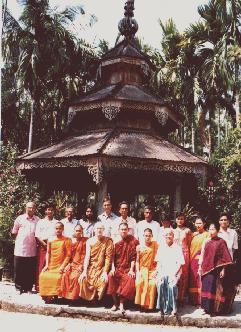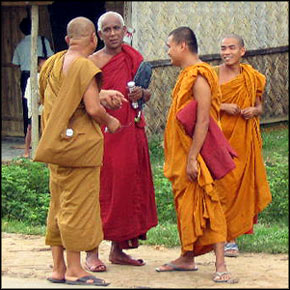That monk who while young devotes himself to the teaching of the Buddha illumines this world like the moon freed from clouds. ~ Dhammapada 382.
 In ancient Bangladesh, Buddhist civilization flourished during the 5th to 12th centuries. From the 13th to the 14th centuries Buddhism existed in the Chittagong and adjoining regions only. During the period of 300 years from 15th to 17th centuries, Chittagong came under the domination of three feuding forces-the Mughals, the King of Tippereh and the Arakanese king who were respectively Muslim, Hindu and Buddhist. During these 300 years until Chittagong came under the dominion of the British in 1774, Buddhism maintained a flickering existence.
In ancient Bangladesh, Buddhist civilization flourished during the 5th to 12th centuries. From the 13th to the 14th centuries Buddhism existed in the Chittagong and adjoining regions only. During the period of 300 years from 15th to 17th centuries, Chittagong came under the domination of three feuding forces-the Mughals, the King of Tippereh and the Arakanese king who were respectively Muslim, Hindu and Buddhist. During these 300 years until Chittagong came under the dominion of the British in 1774, Buddhism maintained a flickering existence.
Some of the ancestors of the present day Buddhists also migrated here from the Bihar state of India in the 11-12th centuries. During this period of Brahminism resurgence in India, devout Buddhists had felt endangered and many fled from some areas of Northern India, undertaking a long, arduous journey through Assam into Chittagong. These Bengali-speaking Buddhists, thus maintain an unbroken lineage from the original Buddhists of the Indian sub-continent.
During the 18th century, Buddhism maintained its precarious existence and greatly degenerated. They began worshiping deities alien to Buddhism and were even making small sacrifices in the name of gods. Monks became ignorant of the Vinaya and performed the roles of priests for marriages and social occasions. There were no religious books and debased forms of suttas were chanted in a language, which was a mixture of Pali and Arakanese.
The mid 19th century was a turning point in the religious history of the Buddhists of Chittagong. The Sangharaja of neighboring Arakan, which today forms the south-west corner of Myanmar, Venerable Saramedha Mahathero came on a chance visit to Chittagong in 1856. He was shocked to see the condition of Buddhism there which incorporated with Tantric rituals and worship of various gods. Ven Saramedha again visited Chittagong and Chittagong Hill Tracts in 1864 and took upon himself the task of reforming the practice of Buddhism in accordance with Dhamma and Vinaya of the Tipitaka. Although faced with many difficulties, he succeeded in gaining the support of Rani Kalindri, the ruler of the Chakma dynasty of the Chittagong Hill Tracts.
Beside the Bengali Buddhists in the plains of the Chittagong district, a large number of Buddhists resided in the hilly regions of the Chittagong Hill Tracts. They were largely of the Chakma tribe, believed to be of Tibetan-Myanmar-Thai origin. Another group of Buddhists are the Bomangs who are settlers from neighboring Arakan from several hundred years ago. All these three groups were thus united together in the common bond of Theravada Buddhism.
 The Theravada-based religious reformation movement inspired the monks and people of the region. Eventually, they discarded their Tantric practices and other superstitions and the monks were given fresh ordination and initiated into the Theravada monastic disciplines. Such was the success of the reformation movement that more then 95 percent of the total number of Buddhist monks in Chittagong and Chittagong Hill Tracts and other Buddhist populated regions came under the fold of the newly reformed Theravada Buddhist Sangha. This led to the establishment of a reformed Bhikkhu Sangha popularly named as Sangharaja Nikaya. Following the Sangharaja Saramedha’s footsteps, Acharya Dhammadhari Punnachara who was the first monk of then Bengal in the 19th century to be educated and trained in Sri Lanka became the first Sangharaja of Bangladesh.
The Theravada-based religious reformation movement inspired the monks and people of the region. Eventually, they discarded their Tantric practices and other superstitions and the monks were given fresh ordination and initiated into the Theravada monastic disciplines. Such was the success of the reformation movement that more then 95 percent of the total number of Buddhist monks in Chittagong and Chittagong Hill Tracts and other Buddhist populated regions came under the fold of the newly reformed Theravada Buddhist Sangha. This led to the establishment of a reformed Bhikkhu Sangha popularly named as Sangharaja Nikaya. Following the Sangharaja Saramedha’s footsteps, Acharya Dhammadhari Punnachara who was the first monk of then Bengal in the 19th century to be educated and trained in Sri Lanka became the first Sangharaja of Bangladesh.
The new Bhikkhu Sangha produced outstanding religious figures. Several played a role in the resurgence of Buddhism in the Indian sub-continent initiated by the anagarika Dhammapala of Sri Lanka. Ven Kripasaran Mahathero of Chittagong founded the first vihara in Calcutta in 1892. He also set up monasteries in Lucknor, Jamshedpur, Darjeeling and Shilong, all in India.
The reformation movement continued into the 20th century. Ven Prajnaloka Mahathero of Chittagong set up a printing press for publication of Theravada books for Bengali speaking Buddhists of the sub-continent. Together with Ven Vangshadipa and Ven Jnaniswara, he campaigned against prevailing social superstitions and wrong practices to uphold the spirit of the reformation. This period also saw the emergence of a group of scholars on Buddhism. The most outstanding scholar of world repute was Dr. B. M. Barua (1888-1948), Professor of Pali and Buddhism in Calcutta University. In 1944 during his visit to Sri Lanka on a lecture hour on Buddhism, the Vidyalankara University conferred him with the title ‘Tipitakacharya’. A brilliant disciple of Ven Prajnaloka, the Ven Shilalankar edited the Buddhist journal “Sanghashakti” from 1933 to 1941 and succeeded in turning the journal as intellectual and socio-religious mouthpiece for the Buddhist community which was confidently emerging into a distinctive identity. He was also the secretary of the Buddhist Mission which was founded in 1928 by Ven Prajnaloka to propagate Buddhism through publication of Buddhist books and suttas in Bengali, setting up of a Pali institution, free religious schools and libraries.
However, Buddhism in Bangladesh continues to suffer. Religious persecution against tribal people in the Chittagong Hill Tracts has been a marked feature of ongoing conflict, committed by the military and settlers. As Buddhists constitute a small fraction of the country’s population, the community is constantly threatened. Land in the Hill Tracts area have been given to low-land settlers and the Chakmas and other tribes often have to flee conflict and enter as refugees into neighboring Myanmar.
Forced assimilation of the people into the majority culture of Bangladesh had been the policy of the Government and the military since 1975. Religious persecution occurs in different forms including forcible conversion of people from their native Buddhism, destruction and desecration of viharas, prevention of worship and forcible marriage.
Sources:
- Edited from various sources, but largely from articles written by Ven.Prof.Prajnabangsha Mahathero
- Religious Persecution in the Chittagong Hill Tracts
Photos:
- Photo 1: Vihara in the style of the Rakhaing tribe.
- Photo 2: Bangladeshi monks.
Photos from Buddhist Peace Fellowship, Bangladesh